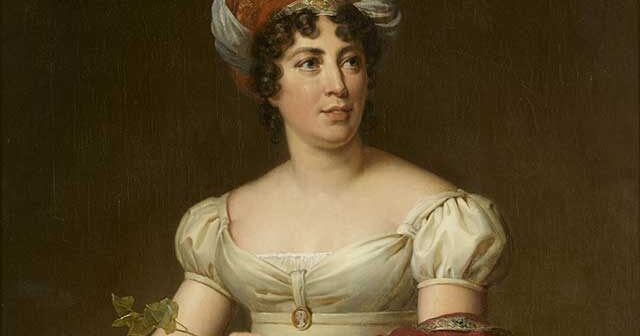The following article was originally posted on the Literary Ladies Guide website.
Madame de Staël (April 22, 1766 – July 14, 1817) was a French intellectual, writer, and political theorist. She was a staunch supporter of freedom of speech, democracy, women’s rights as well as a political enemy of Napoleon Bonaparte.
Looking at Germaine’s portrait, with her grandiose turban, silk gown, and shawl draped over her arms, the last thing she brings to mind is an 18th-century French revolutionary, but that is precisely what she was.
The author Francine du Plessix Gray called Germaine “the first modern woman.”
Early Life
She was born Anne Louise Germaine Necker in Paris to wealthy Swedish parents Jacques Necker and Suzanne Curchod. Her father was Louis XVI’s Minister of Finance; her mother hosted a salon where she entertained guests including Edward Gibbon, Voltaire, and Diderot.
A precocious only child, Germaine was allowed to attend her mother’s salons. Protestant and forward-thinking for their day, her parents believed she should be educated in all subjects, and allowed for the influence of Dante, Jean-Jacques Rousseau, and Shakespeare in her studies.
At the age of twenty, she began to publish her work, starting with the novels Sophie (1786), Jeanne Grey (1790), and Lettres sur J.J. Rousseau (1788).
It was a time of political turbulence in France. Germaine’s father was forced into exile due to financial mistakes, political opposition, and Marie Antoinette’s animosity. While most would have been sent to prison for such offenses, it’s likely he was given the lesser punishment of exile because he had loaned the national treasury 2.5 million livres. The family fled to their chateau, Coppet, on Lake Geneva in Switzerland.
Marriages and Children
When the family returned to France in 1785, their focus was on a marriage for Germaine. Even as a teenager, she had received marriage proposals, which were promptly turned down by her family.
She was married off to Eric Magnus, Baron of Staël-Holstein, an attaché of the Swedish government who had been promised an ambassadorship to France and a pension by the King of Sweden. Together they had three children – sons August and Albert and a daughter Albertine (though is widely believed that Albertine was actually the daughter of Benjamin Constant, rather than of Baron Staël-Holstein)
Young Germaine had the money, and the Baron had the political stature. It wasn’t a match made in heaven, though it was mutually beneficial to their social status. This marriage ended when Baron Staël-Holstein died in 1802.
She then started a serious relationship with political activist and author Benjamin Constant. Though they never married, they were a politically-minded power couple. Constant once wrote about her, “If she knew how to rule herself, she would rule the world.” It is widely believed that Albertine, was actually Constant’s daughter rather than Baron Staël-Holstein’s. Germaine and Constant separated when he married Charlotte von Hardenberg in 1808.
She remarried in 1816 to the much younger Swiss soldier Albert Jean Michel de Rocca. Together they had a son, Louis-Alphonse de Rocca.
French Revolution
In the early days of the revolution, Germaine lived in Paris, attending the National Assembly, writing, and cheering the fall of Louis XVI.
She hosted an influential salon whose guests included Thomas Jefferson, Marquis de Lafayette, and the philosopher Thomas Paine. Politically, she sided with the radical Jacobins who wanted a parliamentary monarch. However, she gradually moved toward the more moderate Girondists.
In 1793 the Reign of Terror began with mass killings as the Jacobins purged the Girondists. With the help of her father, she escaped to the chateau in Switzerland. In 1795, when the political climate relaxed she returned to Paris.
Napoleon
Napoleon Bonaparte assumed power in 1799. From the start, Germaine and Napoleon disliked one another. The future self-crowned emperor took issue with her political work, partly because she opposed him, and also because he didn’t like outspoken women in political roles. He once told a colleague he wished she would stick to her knitting.
The pas de deux between the two lasted for a dozen years, as she was forced into exile from time to time. She was always writing, always influencing, always lambasting his tyranny and despotism; perhaps she contributed to his eventual downfall. Germaine was the thorn in Napoleon’s side.
Napoleon censored her books Corinne or Italy and De l’Allemagne after she published them in France. He then exiled her from Paris and further retaliated by banishing anyone who visited her in Switzerland.
Exile and Influence
Even in exile, Germaine was highly influential. Her salon at Coppet, which Stendhal said was the “general headquarters of European thought,” was visited by Francois-Rene de Chateaubriand, Lord Byron, and Prince Augustus of Prussia.
In her years of exile, she traveled to Austria, Germany, Russia, Sweden, England, Italy, and Turkey – always writing, always socializing. She met with Czar Alexander to talk politics, influencing treaties between Russia and Sweden as well as England and Prussia. After the English defeated France at Waterloo, she convinced the Duke of Wellington to decrease the presence of his Army of Occupation in France.
Literary Legacy
Germaine was a major talent and has been nearly forgotten, unlike her contemporary, Jane Austen. She epitomized romanticism in French literature — the emotional, the lyrical, and the autobiographical. She wrote essays, plays, political treatises, and travelogues, and a memoir of her years in exile. Her novels were often translated and read widely.
In addition to politics, she wrote on controversial topics like adultery, suicide, and even a defense of Marie Antoinette. Over time, she influenced writers like Henrik Ibsen, Herman Melville, Harriet Beecher Stowe, George Eliot, and Elizabeth Barrett Browning, to name a few.
By 1814 the Bourbons had been restored to power and Louis XVIII was on the throne. By then, she returned to Paris, converted to Catholicism, and after a seizure, was paralyzed.
Madame Germaine de Staël died on July 14, 1817, of a brain hemorrhage. Poetically, her death came on Bastille Day, a holiday that marks the beginning of the French Revolution — when the people triumphed over tyranny.
. . . . . . . . . .
Contributed by Tyler Scott, who has been writing essays and articles since the early 1980s for various magazines and newspapers. In 2014 she published her novel The Excellent Advice of a Few Famous Painters. She lives in Blackstone, Virginia where she and her husband renovated a Queen Anne Revival house and enjoy small town life.



